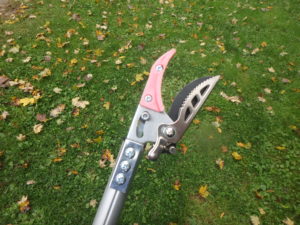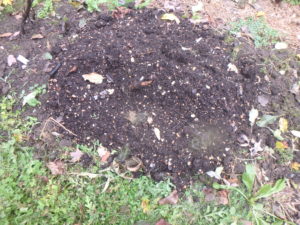Seven Fall Gardening Chores
For many years I was in denial. Yes, I refused to accept that fall and winter were on the way by October. I didn’t start fall clean up until November, and by then it was cold, raw, often wet and unpleasant out. Now, having reached a certain age, I prefer to work when it is warm and sunny – so I start fall clean up in September, and try hard to finish by the end of October. I recommend you do so, too. Here’s my list:
- Clean up the vegetable garden. This means pulling plants – and weeds – and covering the bare soil with mulch. I put things that might harbor disease or insect pests on my burn pile, everything else goes in the compost. So tomato and potato plants and all vine crops go on the burn pile.
As to mulching the soil, I do this for two reasons: First, I don’t want hard rains to wash away my topsoil. That is true everywhere on my property – bare soil invites erosion. Second, bare soil is open to receive wind-blown weed seeds. They would germinate next spring before I plant my tomatoes, if I let them.
What do I use for mulch? In the vegetable garden, I use fall leaves that I have chopped up with my lawnmower. They are great for improving the soil, too. I rarely have bare soil in my flower beds – they are full of perennials.
- Cut back perennials. Cleaning up the beds now, and doing a good weeding, will save me a lot of time in the spring – when I am busy with other spring tasks like planting my vegetables. I don’t cut back everything. I leave flowers with seeds that the finches and other seed-eaters will enjoy. Black-eyed Susans and purple coneflower are two they love. Sunflowers will get eaten in place, and most have already been eaten; if so, I cut down the stalks.
- Blackberries and raspberry plants need to be cut back now. Cut off the stems that produced berries this year and leave the new growth. These berries produce on second year growth.
I have a cut-and-grab pole pruner which helps me to avoid getting scraped by thorns. I just cut the plants at ground-level and the tool grabs on to the cut stem, allowing me to pull it out and place it in the wheelbarrow without getting bitten by the thorns. It is available from The Wildflower Seed & Tool Company (www.wildflower-seed.com or 800-456-3359). These tools come in various telescoping lengths.
- Add fuel stabilizer to your gas can now, so that your lawnmower and other power tools will go into winter with gas that will not go flat. Chain saws, rototillers and such need it too, and you may need to drain out the existing fuel, re-fill and run them for 10 minutes to avoid having gunky gas in the machines in spring. Ask at your local garage or auto part store.
After you have tended to your power tools, take a few minutes to clean up and oil your hand tools, too. Before you put away your shovels and rakes, wipe the metal clean of soil and apply a little light machine oil to prevent rusting. Wooden handles benefit from an application of boiled linseed oil. I have one tool with a wood handle that has been in my family for over 60 years. I don’t leave it outside in the rain, and I oil it once a year. It’s as good as new – and has a lovely patina.
- Divide daylilies, iris, phlox, asters and other large clumps of perennials now. Cut the stalks to the ground, and then lift the clump with a garden fork by going around the clump and loosening the soil on all sides. Then pry it out and divide into 2, 3 or 4 pieces with a shovel or a hand tool. Don’t worry about cutting the roots, they will not be damaged. You can do this in the spring if you prefer. This is also the time to move peonies, if you must.
- Feed your soil and lawn. Fall is a good time to add compost, fertilizer and limestone to your soil and lawn. I test my soil pH with a little kit that costs just about $5. I aim to have my soil pH between 6.2 and 6.8, which is just slightly acidic. If the pH in your soil is lower than 6.0, you should add limestone to raise the pH (except for blueberries, hollies and rhododendrons, which like acidic soil).
Adding compost will improve almost any soil. I added it to my vegetable garden for 30 years, and now have a soil so rich and black I need not add any more. Fertilizer? I only add organic fertilizers as they add all the micronutrients plants need, but that are not in chemical fertilizers. And organic fertilizers are slow-release.
- Lastly, mow your lawn before the snow flies. Bring the blades down lower, as a shorter cut will help to minimize risk of fungal diseases. Rake it if need be, so there are not clumps of grass left on the lawn.
Getting ready for winter is satisfying for me. It’s like tucking a child into bed. And I like looking out the windows and seeing a tidy garden, all ready for spring. Have at it!
Send comments or questions to Henry at henry.homeyer@comcast.net. Henry is a UNH lifetime Master Gardener, and the author of 4 gardening books.





